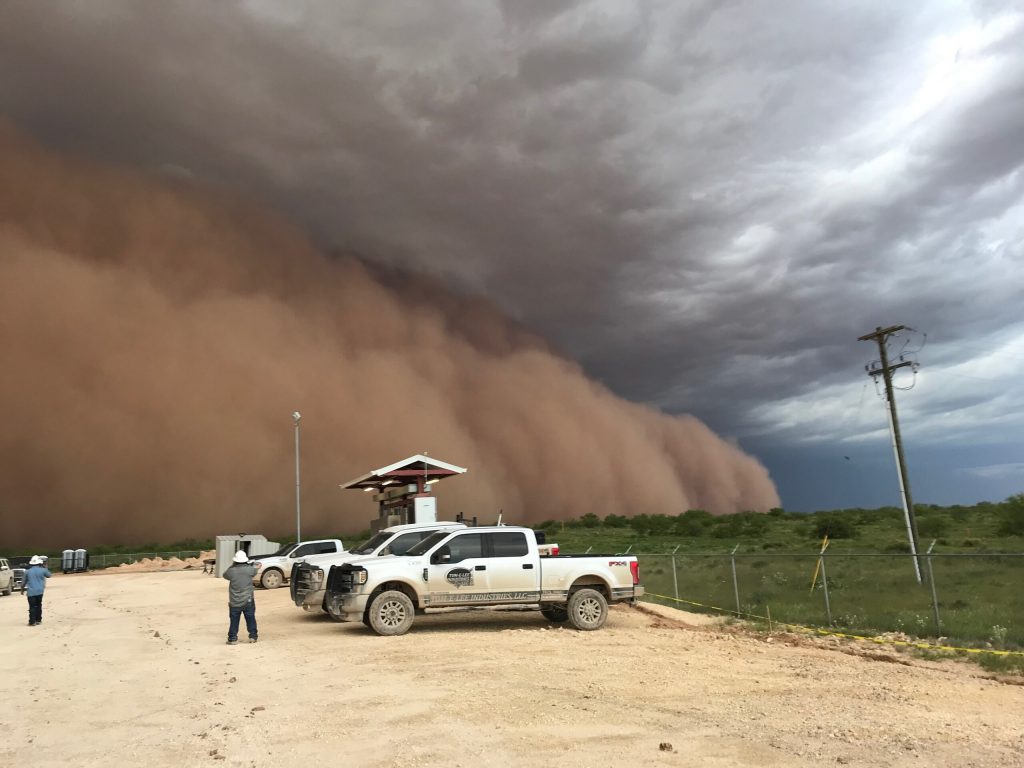The month of March is known for wind. Which we’ve experienced plenty of in the last month. And of course April is known for showers. But let me tell you, April is no slouch in the wind department.
As you’re probably seeing right now, wherever you stand, in the Permian Basin.
As I write these words, in West Texas, the skies have been whipped into a powdery-looking slate gray, and the air is blustery—when it’s not blowing a gale.
Any time of year, we experience dust, wind, windblown sand, earthquakes, and—especially in spring—mosquitoes. In summer it’s extreme heat. It all comes with the territory. So, how does the Basin stack up as a place of coping with the elements? Are we leaders in any category?
What you’ll get here is an unscientific ranking, based purely on anecdotal evidence.
On March 4, USA Today reported on a storm in New Mexico and Texas, saying that regions there were “temporarily shrouded by a brown mist [March 3] when a weather event swept through both states…. Dust storms known as haboobs and high-speed wind gusts that fuel its movement made ‘travel hazardous’ across the central and southern Plains, the National Weather Service said.”
Since a haboob is, according to the American Meteorological Society, “an intense sandstorm or dust storm… reaching heights as high as 5,000 feet,” I’ll treat it as a phenomenon of both sand and dust. Do an image search on Google for the term “haboob,” and what you’ll get are largely scenes of the Permian Basin. Notice, too, that when the website Wikipedia.com set itself to explain what a “haboob” is, they use for their illustration a haboob that hit Big Spring, Texas. (See photo.) Based on all of this, I’m going to give the highest ranking in dust and sand to the Permian Basin, over other parts of the country.
As for earthquakes, well, again, while I was working on this issue, the 4.8-Richter Scale earthquake from near Stanton jarred the room where I was typing. In Abilene, Texas. Within one minute I had posted this fact on Twitter, giving my location, and asking if others had felt it. Within three minutes I got replies from San Angelo, Lubbock, Midland, and more, all in agreement.
Yet for all of that, I’m going to give the earthquakes “win” to California, because we all know that their quakes are bigger—sometimes on the 7.0 level, since California is falling into the Pacific Ocean.
Now, as for just wind in general… I’ve felt plenty, and you have too, in the Permian. But my long years as an editor have taken me many places, including four years in Wyoming, and there I experienced wind on a scale like nowhere else. Cheyenne, Wyo., is itself supposed to be the windiest city in the United States, topping even Chicago. But if personal experience counts for anything, I say Chugwater, Wyo., takes the top spot. Chugwater lies about 45 miles north of Cheyenne, on I-25. A few miles north of the Chugwater exit, a roadside wind sock tops a sign that says, “Caution: high winds.” Once, many years ago, I came upon that sign and saw the sock stretched perpendicular, straining under the force of the wind. Not that that was terribly unusual at Chugwater. After all, they had a wind sock there. I glanced across the median to the lanes of approaching traffic, and there saw a semi tractor-trailer lying flat on its side on the highway shoulder, downed by these winds.
 Just off the interstate exit for Chugwater there is a little gas station and store. Many are the times I’ve pumped gas there. I’ve chased my hat across their parking lot more times than I want to remember. It’s a shameful thing for someone to have their cowboy hat blow off. Having your hat blow off suggests you might be something less than a card-carrying, bona fide member of the cowboy tribe, and who wants to look like that? One time I pulled up to the gas pump at Chugwater and opened my door and it cupped the wind and whoosh!… the door whipped outward to its full extension, hard, making a sickening pop. Hoping to avoid a sprung hinge, I had lunged, grabbing for it, and as I did, my straw quit my head as though it were shot from it, sailing about a hundred feet before its first bounce. Off I bolted in pursuit, in a wild, un-cool, wind-aided sprint. I flew along faster than I would dream—or dare—of going. Still, papers from off my dashboard passed me.
Just off the interstate exit for Chugwater there is a little gas station and store. Many are the times I’ve pumped gas there. I’ve chased my hat across their parking lot more times than I want to remember. It’s a shameful thing for someone to have their cowboy hat blow off. Having your hat blow off suggests you might be something less than a card-carrying, bona fide member of the cowboy tribe, and who wants to look like that? One time I pulled up to the gas pump at Chugwater and opened my door and it cupped the wind and whoosh!… the door whipped outward to its full extension, hard, making a sickening pop. Hoping to avoid a sprung hinge, I had lunged, grabbing for it, and as I did, my straw quit my head as though it were shot from it, sailing about a hundred feet before its first bounce. Off I bolted in pursuit, in a wild, un-cool, wind-aided sprint. I flew along faster than I would dream—or dare—of going. Still, papers from off my dashboard passed me.
I got my hat, finally, but left my dignity there. And Wyoming gets the nod for strongest wind.
Now as for mosquitoes… While some might say that mosquitos in the Permian Basin are as bad as they get anywhere, I’ve got that one beat. And, again, I’m giving the crown to Wyoming.
I worked on a ranch in the region of the Grand Tetons for one summer when I was a teenager, and there, near the tiny community of Moran, hard beside the marshy bottoms of the Buffalo River, we were beset with the most ferocious swarms of mosquitoes to be found anywhere. Lest anyone dismiss this contention as mere hyperbole, consider this. A country with a healthy mosquito population today is likely one that has always had them. In a book written more than 175 years ago, The Journal of a Trapper, Osborne Russell’s classic account of travels through the Rockies and much of the American West, Russell told of venturing through that same exact country I later worked in. Though he scarcely bothered to mention mosquitoes anywhere else in his book, on that occasion he chose to describe the little buggers in his strongest terms. If a mountain man, tough and uncomplaining as they were, had to confide to his dear diary how the area was “infested with horse flies and musketoes to the great annoyance of man and beast,” then that was indeed mosquito country.
So Wyoming gets the mosquitoes recognition.
That leaves heat. And as everyone reading this magazine knows, there is no heat like the ferocious heat of the Basin in July, when the sun’s blast furnace rays beat down on you and even reflect back up from the bleached, hardpan ground, cooking you from above and below, even while turning steel into searing metal. It is on these days that the wind stops, by the way.
And so, when we tally it up, we get a win for California, two wins for Wyoming, and three for the Basin. So the winner is clear. Advantage Permian. Or should that be “advantage” Permian?
Jesse Mullins, editor of Permian Basin Oil and Gas Magazine, can recall working as a young man on the framing crew that built the Motel Six in downtown San Angelo during what was then the state’s record-setting heat wave. Yes, the wind stopped then, too.










Leave a Reply